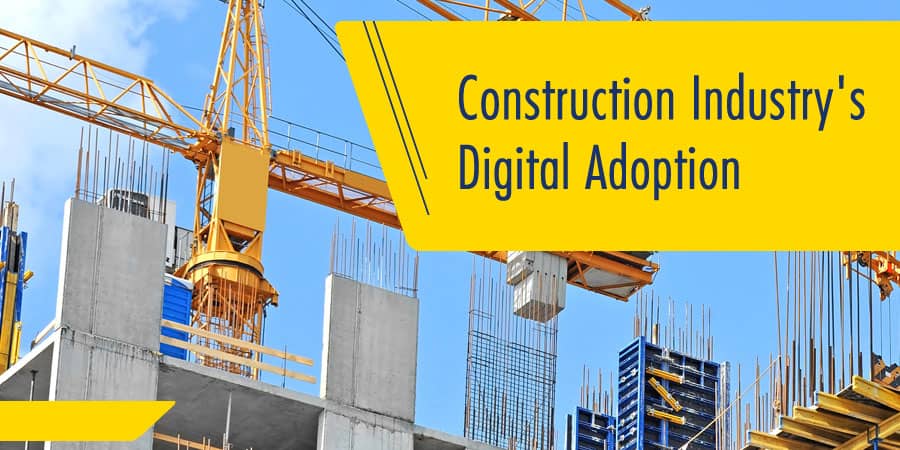Construction Industry's Digital Adoption

Construction Industry's Digital Adoption
The construction industry is traditionally slow in adopting new technologies, but recent years have seen a surge in digital adoption. The industry has realized the potential of digital technologies in improving efficiency, reducing costs, and enhancing safety. In this article, we will explore the current state of digital adoption in the construction industry and the trends that are shaping its future.
Introduction
The construction industry has been known for being slow to adopt new technologies, but that trend is changing as digital adoption becomes increasingly popular. In this article, we'll explore the current state of digital adoption in the construction industry and how it's shaping the industry's future.
Current state of digital adoption in the construction industry
Despite its slow start, the construction industry is making significant progress in digital adoption. According to a report by McKinsey & Company, the construction industry is the second-least digitized industry in the world, with only agriculture trailing behind. However, the industry has begun to embrace new digital technologies in recent years, with Building Information Modelling (BIM), drones, and mobile applications becoming increasingly popular.
Factors driving digital adoption in the construction industry
One of the major drivers of digital adoption in the construction industry is the need for greater efficiency. Construction projects are notoriously time-consuming and expensive, with delays and cost overruns often occurring due to a lack of coordination and communication. Digital technologies can help to address these issues by improving project management and communication, reducing waste and errors, and streamlining workflows.
Another driver of digital adoption is the need to improve safety. Construction is one of the most dangerous industries, with workers often exposed to hazardous conditions and accidents. Digital technologies such as drones, wearables, and IoT devices can help to improve safety by monitoring conditions and providing real-time feedback to workers.
Challenges to digital adoption in the construction industry
Despite the benefits of digital adoption, the construction industry faces several challenges in implementing new technologies. One of the main challenges is resistance to change. The industry has traditionally been slow to embrace new technologies, and many workers are resistant to change.
Another challenge is the lack of a skilled workforce. Many construction workers do not have the skills or training needed to use digital technologies effectively, and there is a shortage of workers with the necessary technical expertise.
High costs are also a significant barrier to digital adoption. Many digital technologies are expensive to implement, and the industry may not have the financial resources to invest in new infrastructure.
Finally, there are concerns around data privacy and security. Construction projects involve sensitive data such as building designs and financial information, and there are risks associated with storing and sharing this data digitally.
Digital technologies adopted in the construction industry
- Building Information Modelling (BIM)
- Drones and robotics
- Cloud computing and collaboration tools
- Mobile applications and wearables
- 3D printing
Benefits of digital adoption in the construction industry
- Improved project management and communication
- Enhanced safety
- Increased productivity and efficiency
- Reduced costs and waste
Future trends in digital adoption in the construction industry
The future of digital adoption in the construction industry looks bright, with many new technologies on the horizon. Smart cities and IoT devices are becoming increasingly popular, with sensors and connected devices being used to monitor conditions in buildings and on construction sites. Augmented and virtual reality are also gaining traction, with 3D models and simulations being used to visualize projects and identify potential issues.
Artificial intelligence and machine learning are also playing a significant role in the industry. These technologies can analyze data to identify patterns and make predictions, helping to optimize workflows and improve project outcomes.
Blockchain technology is another trend that is expected to have a significant impact on the industry. Blockchain can be used to track materials and products throughout the supply chain, providing greater transparency and traceability.
Finally, cybersecurity and data protection are becoming increasingly important as the industry becomes more digitized. Construction companies must ensure that they have robust security measures in place to protect sensitive data and prevent cyberattacks.
Challenges to digital adoption in the construction industry
- Resistance to change
- Lack of skilled workforce
- High costs of digital technologies and infrastructure
- Data privacy and security concerns
Conclusion
The construction industry has made significant progress in digital adoption, but there is still a long way to go. Digital technologies have the potential to revolutionize the way construction projects are planned, designed, and executed. However, the industry needs to address the challenges to digital adoption and invest in the training of a skilled workforce to fully realize the benefits of digital technologies.
FAQs
What is digital adoption in the construction industry?
Digital adoption refers to the integration of digital technologies into the construction industry's processes and operations to improve efficiency, reduce costs, and enhance safety.
What are some of the digital technologies adopted in the construction industry?
Some of the digital technologies adopted in the construction industry are Building Information Modelling (BIM), drones and robotics, cloud computing and collaboration tools, mobile applications and wearables, and 3D printing.
What are the benefits of digital adoption in the construction industry?
The benefits of digital adoption in the construction industry include improved project management and communication, enhanced safety, increased productivity and efficiency, and reduced costs and waste.
What are the future trends in digital adoption in the construction industry?
The future trends in digital adoption in the construction industry include smart cities and Internet of Things (IoT), augmented and virtual reality, artificial intelligence and machine learning, blockchain technology, and cybersecurity and data protection.
What are the challenges to digital adoption in the construction industry?
The challenges to digital adoption in the construction industry are resistance to change, lack of skilled workforce, high costs of digital technologies and infrastructure, and data privacy and security concerns.
